Steve Morrisette
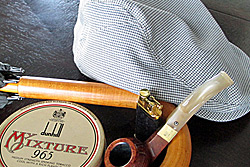 As the weather stubbornly remains cold and inclement for the most of us in the northern hemisphere, a column on hats, gloves and umbrellas, as well as smoking al fresco seems timely. Naturally, as a gentleman smoker, you will want to observe the etiquette and some traditions associated with those accoutrement. Many of these practices, as with most gentlemanly conduct, are holdovers from the 19th century. That it was a time of broad observance of a “proper” public demeanor is well known. The passing out of style and habit of so many polite gestures and displays of respect was the result of the late 20th century’s headlong pursuit of egalitarianism.
As the weather stubbornly remains cold and inclement for the most of us in the northern hemisphere, a column on hats, gloves and umbrellas, as well as smoking al fresco seems timely. Naturally, as a gentleman smoker, you will want to observe the etiquette and some traditions associated with those accoutrement. Many of these practices, as with most gentlemanly conduct, are holdovers from the 19th century. That it was a time of broad observance of a “proper” public demeanor is well known. The passing out of style and habit of so many polite gestures and displays of respect was the result of the late 20th century’s headlong pursuit of egalitarianism.
I am all for equality, but we seem to have pitched the baby out with the proverbial bathwater. There is a vast difference between showing respect and politeness through gestures and the incumbent demand of an obligatory salute or sign of obeisance to a superior or someone in authority. Certainly it is good to lose the shackles of class ( or any other ) restrictions, but we seem to have become very uncivil in the process. It is as though politeness and respectful behavior are to be shunned and derided as weakness, or worse yet, as cowardly subservience. If we are to shun anything, let it be rude and uncivil behavior. While many may regard traditional displays of respect as stiff and too formal, those receiving them tend to feel just a bit more cheerful. And spreading even just a little good cheer has it’s own rewards.
When you tip your hat, remove a glove to shake hands, or shield a lady with your umbrella, you are showing respect and kindness. You are also making the most of an opportunity to create a civil and polite atmosphere that benefits all. This is what a gentleman does; it is part of who he is. This is true of a lady as well, of course. And as “gentlepeople", responding to such acts and gestures in kind helps to perpetuate and expand their influences. So in this regard, allow me to proceed with some thoughts on a gentleman’s cold and foul weather gear and some applicable etiquette.
 To begin with, let us all be mindful of the chill season’s wind. Old Man Winter loves to snatch a hat off a head, turn an umbrella inside out and block our vision with the end of our scarves. You may think it obvious, but I wish to say that if it just slightly occurs to you that the wind might be troublesome, take extra note and precautions. Hold your hat on your head, perhaps forego using that umbrella and carefully tuck in that scarf. Losing a particularly fine hat, or unceremoniously chasing it into traffic is at best lamentable, and at worse undignified and dangerous. Dangerous also is your umbrella inverting itself and poking out your companion’s eye or your scarf blinding you just as you descend the stairs to the subway.
To begin with, let us all be mindful of the chill season’s wind. Old Man Winter loves to snatch a hat off a head, turn an umbrella inside out and block our vision with the end of our scarves. You may think it obvious, but I wish to say that if it just slightly occurs to you that the wind might be troublesome, take extra note and precautions. Hold your hat on your head, perhaps forego using that umbrella and carefully tuck in that scarf. Losing a particularly fine hat, or unceremoniously chasing it into traffic is at best lamentable, and at worse undignified and dangerous. Dangerous also is your umbrella inverting itself and poking out your companion’s eye or your scarf blinding you just as you descend the stairs to the subway.
And your pipe? The red hot ash. You may only have to relight, but you must at all costs avoid burning someone to the side or behind you with those flying ashes. And I hope you will take extra, extra care in dry, fire prone areas. You may think of this as outdoor etiquette and safety as well. Etiquette has it’s practical elements too, you see.
Bowls in the cold
Generally, briar pipes are very resilient. This is why they are the most common type of bowl by far. Even thin walled briar pipes are rather strong when compared to thin walled meers and clay pipes. I would, however, recommend against smoking thin walled pipes out of doors in chilly or windy weather. It is too easy to allow a hot spot to begin from the wind or have the bowl overheat unnoticed. This brings me to thinking about other considerations in outdoor cold, or inclement weather smoking.
If your bowl is very cold, it is a good idea to warm it in an interior pocket, or some other warm spot so as not to shock it unnecessarily when it is packed and lit. I find, for me in very cold weather while smoking my pipe wearing gloves, that if I test the temperature of the bowl against my bare cheek I can avoid overheating it. The ambient cold and any wind combined with the insulation of gloves can result in unnoticed overheating if you tend to be a hot smoker that day.
I always try to avoid smoking my pipes with horn or ivory adornments outside in cold weather. Both horn and ivory are organic tissue and as such quite vulnerable to cracking from rapid changes in temperature and humidity. In fact, any elements added to a briar bowl such as exotic woods, metal bands or any inlay are likely to be stressed by such rapid changes. They expand and contract at a different rate than the surrounding materials which can cause them to loosen up, or indeed, crack.
I remember a ritual that guitars players I worked with adhered to religiously.
Whenever they entered a club where the inside temperature was markedly different from the outside they would briefly open their guitar case and then, without locking it, close the lid again. This was to allow the guitar to slowly acclimate to the new ambient temperature. This was to avoid damage to the finish, or worse, upsetting the architecture of the wooden instrument. I think this is a good practice for our pipes also. When brought in from a cold (or hot) car, open the pipe case, bag or box and allow in a breath of room air and then give them a few minutes to acclimate before lighting up.

2005 Fender Stratocaster, 1957 re-issue. Pipes top-to-bottom: Adam Davidson Military Mount Billiard with Silver Band, Dunhill Dress 32121, 1965 Comoy Sandblast Sterling Silver HC hallmark that inspired the AD pipe. All owned by Kevin Godbee.
Photo © 2014 Kevin Godbee
Hats, gloves and umbrellas
I resist referring to this as a list of rules. It is rather more a collection of agreed upon practices and traditions in a Western civil society.
Hat etiquette and traditions
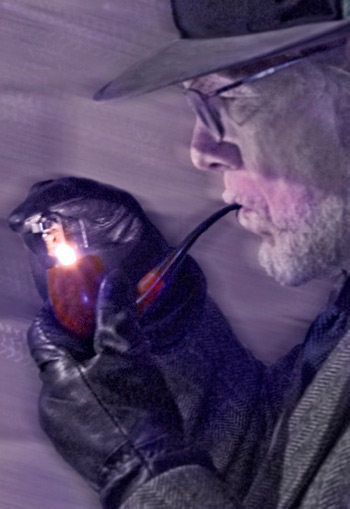 I will be referring herein to the traditionally accepted types of hats and flat caps. Baseball caps, beanies, hoods and other non traditional headgear, though generally an unfortunate look when out of place, can also be considered subject to hat etiquette and traditions. Tipping the hat, or doffing the hat or cap, is done to show polite respect. They are used as a tool in this regard, and as such, are quite useful and unmistakable. A gentleman will tip his hat by grasping the brim and lifting it off the head slightly when encountering a lady, or group of ladies he knows, or when being introduced to a lady. One will also show the same courtesy to the elderly of either sex. If indoors, the hat is removed altogether and held, crown up, in the hand. One never shows the lining to anyone during any gestures with a hat. Never wave with a hat showing the interior. We are gentleman, not Vaudevillian hoofers shuffling offstage.
I will be referring herein to the traditionally accepted types of hats and flat caps. Baseball caps, beanies, hoods and other non traditional headgear, though generally an unfortunate look when out of place, can also be considered subject to hat etiquette and traditions. Tipping the hat, or doffing the hat or cap, is done to show polite respect. They are used as a tool in this regard, and as such, are quite useful and unmistakable. A gentleman will tip his hat by grasping the brim and lifting it off the head slightly when encountering a lady, or group of ladies he knows, or when being introduced to a lady. One will also show the same courtesy to the elderly of either sex. If indoors, the hat is removed altogether and held, crown up, in the hand. One never shows the lining to anyone during any gestures with a hat. Never wave with a hat showing the interior. We are gentleman, not Vaudevillian hoofers shuffling offstage.
When to remove the hat
Generally, indoors: In a domicile, public building, theatre, doctor’s waiting room, house of worship, and hotel lobbies – unless one is proceeding outside. A gentleman removes his hat upon being seated at an indoor meal. It is always good to check one’s hat and coat when possible. There is an unfortunate lack of coat and hat racks in public spaces these days, so one is left to improvise as best he can, without inconveniencing others. Hats are removed for the National Anthem, the Pledge of Allegiance, prayer, the passing of the flag, and during prayer at a grave site.
It is not necessary to remove one’s hat in common public passages such as corridors in buildings, train stations, markets, shops, the post office, or elevators – unless a lady is present or gets on. Given reasonable thought, hat etiquette is quite simple to follow.
Gloves
Gloves should be leather and of good quality. Though buff or dove gray are most acceptable, color is generally not a concern these days, except that clean white cotton or kid is de rigueur for a ball or very formal affair.
In the recent past a gentleman wore gloves regardless of the weather. He had lightweight leather gloves of good quality for warm weather and lined gloves for the cold. This was not only etiquette, but quite practical. Gloves protect the hands from dirt and grime and light injuries of all sorts. If you think this is ridiculously old fashion, consider avoiding flu and other infections when you go to rub your eyes or passing them on when you pick up your child. You can remove your gloves and proceed without concern. Certainly these days one will attract odd looks by donning gloves in temperate weather, especially prior to evening. It is, however, quite proper to wear gloves, even when it is not cold.
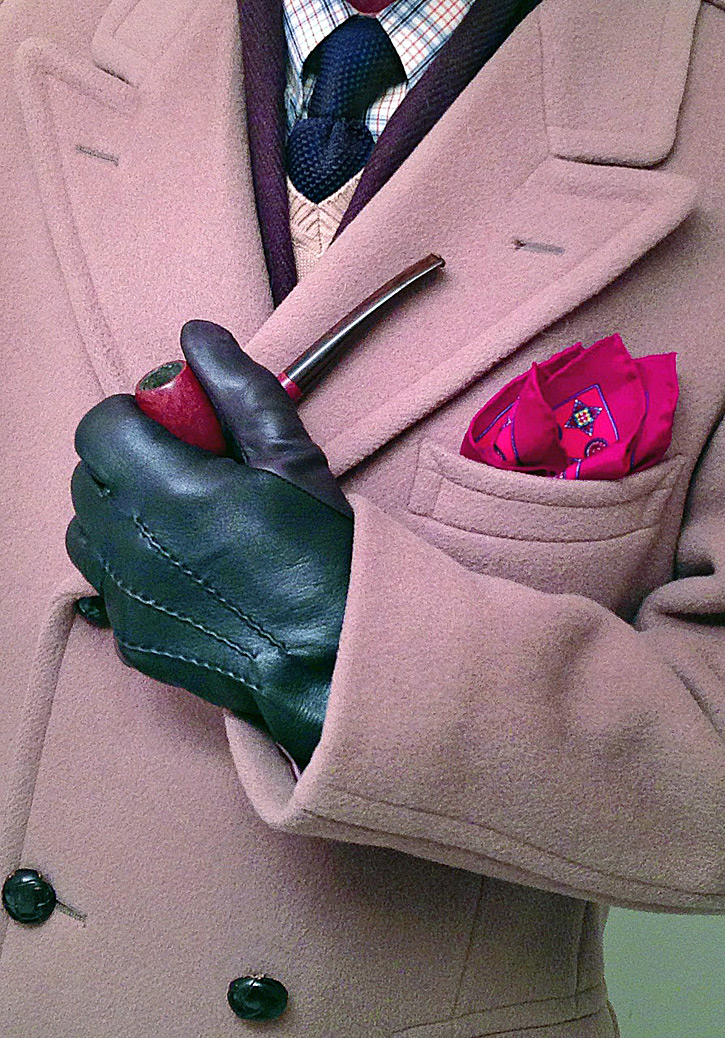
Two Above Photos of Steve Morrisette in His Usual Gentlemanly Attire
Etiquette for gloves
When going indoors where one’s hat and coat are not checked or otherwise taken, gloves are put in a coat pocket, suit coat pocket or the pocket of a jacket.
A glove is removed to shake hands as a sign of respect. Gloves in cold weather keep hands warm and will insure a pleasant handshake when meeting others by avoiding the presentation of icy fingers.
A glove is also handy to challenge the occasional brute or bounder to a duel.
And gloves will protect your hands from gun shot residue, if need be. Please note: Shooting someone is definitely not gentlemanly, no matter how much it is deserved.
Umbrellas
A gentleman’s umbrella is another item that that may seem an anachronistic affectation in modern society, especially in the United States. It is, however, eminently practical for not only staying dry, but for self-defense, hailing a cab or policeman and for reaching the car keys that fell behind the radiator at your favorite bistro.
Personally, I am on a quest to find myself a proper ” brolly “, as the Brits refer to them. I’ve been using one of those ubiquitous tiny collapsible automatic affairs because I thought it would be less bother to haul around. I was wrong. A proper, well made, high quality gentleman’s umbrella is all that is listed above and my midget-auto version is no substitute.
A good umbrella not only will last, but it is also another means of showing gentlemanly manner – that of being prepared. It can and should be shared with a companion in the rain. When fully locked it is handy for fending off attacking dogs or rudely persistent salesmen. It does also extend one’s reach in a tight spot.
Just as with hats and gloves, there is etiquette and some common use traditions regarding the brolly.
First and foremost are the safety considerations:
Be aware of your surroundings. When deploying your umbrella, watch that you do not injure others, block someone’s path or upset nearby objects. Always wait until you have space and are either out the door or about to pass over the threshold.
When walking, watch where you are going. Be aware of tall persons’ faces and the hats of shorter gentleman. Use extra caution during cell calls and no texting.
When furled, carry your brolly as you would a sharp blade; point down. A crooked handle is ideal for this as it hangs on your arm and leaves the hand free.
In winter, take care of those nifty outdoor gas heaters so popular at upscale eateries. Brollys are flammable. Need I mention lightening?
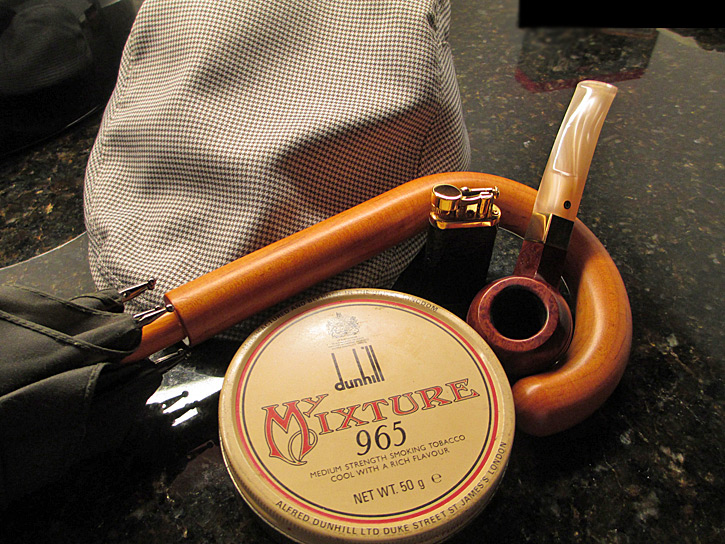
Comoy’s Celebration, Bent Bulldog w/18-ct Gold Band w/HC hallmark, Filson Cover Cloth Umbrella, Docker’s Cap, 1998 Dunhill My Mixture 965 (Made in UK), and IM Corona Old Boy Sandblasted Briar Lighter. All owned by Kevin Godbee. Photo © 2014 Kevin Godbee
Umbrella etiquette
Your brolly should suit your size. A 5 ft., 125 lb. man does not require a golf umbrella.
Always yield the right of way, especially to those unfortunate souls running by because they do not have a brolly. Close the umbrella when under a large awning, hotel entrance overhang, or bus stop.
Do not block entrances fumbling to close the brolly. Those behind you are getting soaked and angry.
Once inside, do not place your wet brolly on a seat. When one is provided, place it in a stand and remember which is yours when you go to retrieve it.
Be patient with others that forget brolly etiquette. Rain storms tend to rattle some folks.
In Conclusion
Lastly, and very important to note on etiquette, one never makes reference to another’s lack of good manners or etiquette – even to oneself. It would be unfortunate to regard etiquette as some heavy yoke to chafe against. Perhaps if one’s perspective were on what one expects of themselves, rather than what others expect of them, the term “etiquette” would conjure thoughts of fraternity rather than of suppression. I, for one, hold myself in higher regard when I aspire to show respect, courtesy and kindness to others. Is it not also true for you?
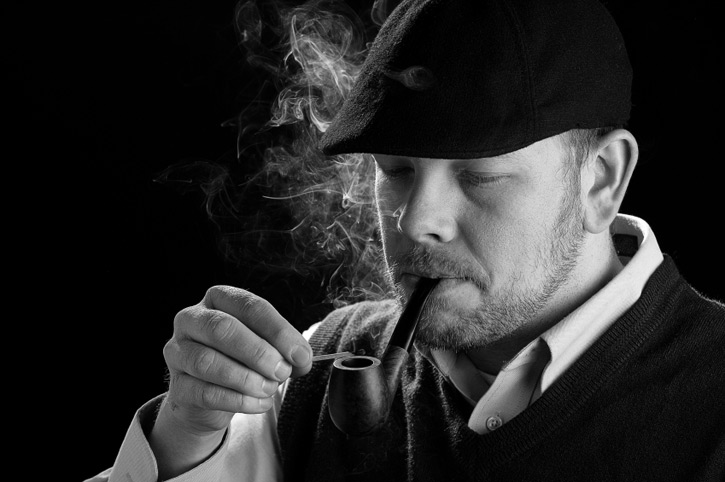
The Gentleman Smoker’s Tip
If your leather gloves become soaked by rain or snow, just lay them out on a clean cloth or towel and allow them to slowly air dry. Do not apply heat, or place them near a heat source. Leather is skin after all and will recover nicely if not forced dry. Some good quality leather care product my be applied in extreme cases, but only after they dry completely.
Resources
Brooks Brothers – Of Gentleman and Rogues, blog.brooksbrothers.com
How to be a Gentleman – book, at http://www.brooksbrothers.com
LifeHacker.com – blog; umbrella eitquette
|
Steve Morrisette is an artisan pipe maker, relentlessly snappy dresser, and self-confessed Virginia gentleman. He makes artisan pipes for discerning collectors, and scours the internet and shops of all types seeking information and fine garments, hats, watches, shoes, and jewelry – anything related to the gentleman’s lifestyle. Steve also spent several decades as a working drummer and photographer/photojournalist. You can find his pipes at www.smpipes.com, and catch his style photos and latest pipes on Facebook and Instagram. |




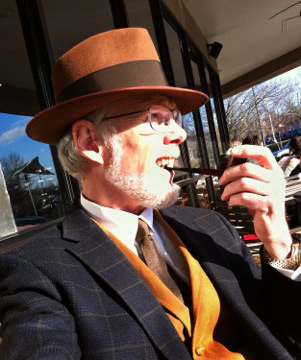
















Great article Steve. I grew up in a time where manners and proper etiquette were taught and I was expected to follow them always. I have taught my kids how to behave and they do a good job. I have seen all too often how their friends are totally clueless what proper etiquette is all about. Since I am 6’4″ and go 225, my golf umbrella looks appropriate. I always have it in my car as here in Florida it gets quite a bit of use. Our society would do well if manners and etiquette were taught in elementary school so it would be ingrained in all children.
The one thing that annoys me to the extreme is to see some character sitting at a table eating a meal with his cap on his head or any other indoor venue. Also lately it’s been the use of ipads and cellphones at the meal table with others present. I’ve actually seen entire families busily playing with their individual ipads while ignoring the presence of other family members including parents.
Disgusting. It’s shameful how lacking of even the most basic of manners we have become.
Smoking etiquette is another matter for sure.
We’ve forgotten or ignored some many etiquette rules over the years. We all need new training or I’ve become another old geezer.
Oh, I also forgot to mention how people handle their eating utensils. You don’t grasp your fork with your fist. and you don’t shovel the food in large quantities into your mouth like its your one and only meal in days.
How you handle the “social graces” is a reflection on your true character.
Great article Steve, especially useful on the care of briar and leather before, during, and after weather. I always forget that they are – as you say – natural products and need to be treated as such.
A key lesson for me over the past years has been the importance of appropriate coats and hats. I work in the city but live in the country. I go out in rain and cold but often not at the same time (unless it’s snowing!). My tweed coat is ideal for the weekend but doesn’t work practically or aesthetically over a business suit. And vice-versa for my Crombie overcoat.
Most useful is my mac; it’s not tough to go out without a coat to make a point and it’s definitely not cool turning up to work or a meeting soaked because you were caught in the showers forecast by the weatherman. A decent mac is stylish yet very versatile and combined with a flat cap normally means I don’t need a brolly. Over 350,000 people commute into my office location every day. If it rains, the crowds produce umbrellas of all shapes and sizes, turning the pavements into giant testudos and causing an endless series of high-level clashes. I cruise along, compact and dry as I negotiate the tangles and stand-offs (often caused by the golf brollies wielded by the ‘young turks’ as they charge to the dealing floors and brokerage houses).
Andy
Steve, congratulations for the oportunity to write this column and for the excellent articles so far.
I’m jumping into the “discussion” to adress the hat etiquette subject, especifically the need to remove one’s hat while having a meal and the negative conotations it might have (especially in the US), just like expressed by Oldtom’s comment.
I consider myself a respectful man, with an honest interest in style and in gentlemanship, both by nature and upbringing.
However, I must confess to be “guilty” of seldom taking a meal with my head covered, but also surprised by how strongly lacking of manners many might consider it (although I have never directly experienced any negative reactions).
All “rules” have a reason of being, and hat rules seem to be evocative of a time in which warriors wore protective helmets, which is why tipping the hat or removing it in certain circunstances equals to a gesture of vulnerable galantry, friendship, trust, and peaceful intent.
Nevertheless, I think the reasons for such negative conotations are essencially connected to religion and the grace of the meal. Well, I’m not religious and feel not at all obliged to correspond to religious observances outside of places of cult.
You see, one of the reasons I often wear a hat is to hide my messy hair underneath, the result of either some intense physical work or simply the result of not having showered in the morning, and I’m convinced that, while seating for a meal, the sight of my hair in such occasions is far more repulsive and disturbing to others than the sight of a small flat cap.
There are obviously certain circunstances and places I would never wear a hat, such as in court, but even as a lawyer I’m not attending court two or three times each day, while I do sit on a table for a meal at least those many times…
So, I would like to question: why exactly is it considered so rude?
Gustavo – you should consider transferring to England if you work as a lawyer. We get to wear wigs in court so our untidy hair can be covered!
RE: hats at dining tables it simply is showing proper respect for the cloth and your host. As you say the habit evolved from removing ones armoured helm to show amiability and respect, and dining at ones table is a perfect time to show this respect. Removing the hat in public every time you saw someone and wished to say good day would be impractical which is why a “tip” of the hat is allowed.
Mores the pity that no one wears hats (Top Hats and Bowlers) anymore as a matter of course. I blame Kennedy and the 60’s in general!
Steve – if you’re on the lookout for a proper brolly and are ever in London (England) try James Smith and Sons of Holborn. Its a wonderful little shop that makes and sells canes and umbrellas for the discerning gentleman.